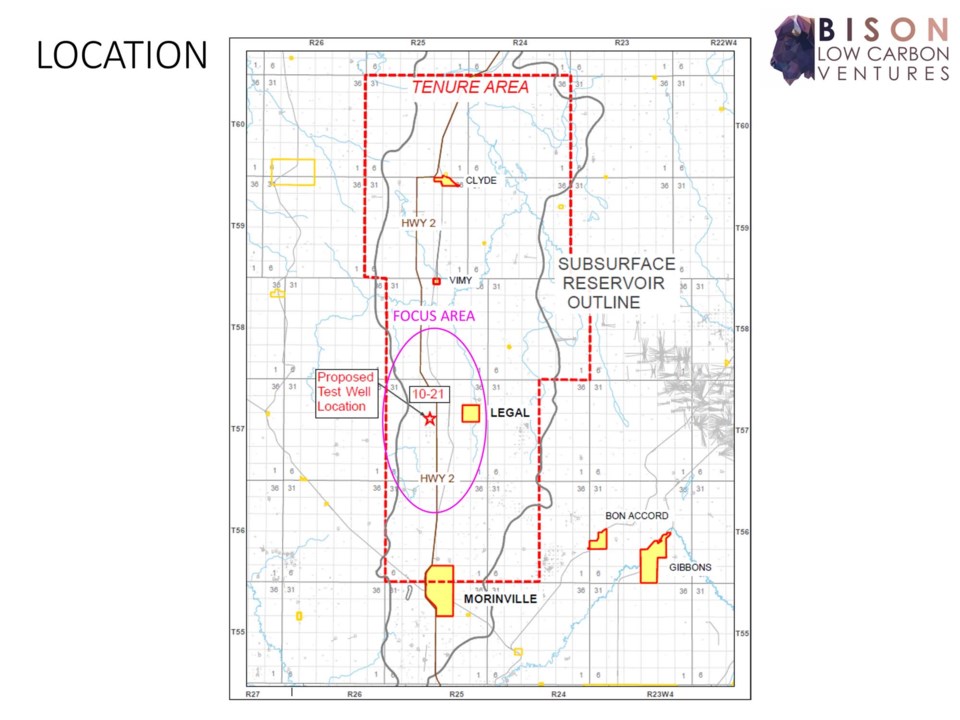A farm west of Legal could become home to one of Sturgeon County’s first carbon capture and storage hubs in four years, county council has learned.
Bison Low Carbon Ventures spoke to Sturgeon County council Oct. 11 during committee of the whole about their plans to build a carbon capture and storage hub west of Legal and north of Morinville. The company held an open house on the hub at Morinville’s Community Cultural Centre later that day.
Carbon capture and storage (CCS) is a process where carbon dioxide is removed from the air and stored underground to reduce global heating. Analysts see it as a way to address greenhouse gas emissions from high-carbon industries such as cement and as a way to produce low-carbon (“blue”) hydrogen from natural gas.
Alberta has two commercial-scale CCS operations backed by provincial funding: the Quest project, which pumps about 1.08 megatonnes (Mt) of emissions from the Shell Scotford upgrader underground each year, and the Alberta Carbon Trunk Line, which takes CO2 from the Sturgeon Refinery and the Nutrien Redwater fertilizer plant and uses it to boost oil production.
In 2021, the Alberta government put out a call for companies to develop carbon storage hubs. Bison Low Carbon Ventures was one of several groups picked to build a hub in the Alberta’s Industrial Heartland region.
Carbon storage
Industrial plants in the Heartland have to pay carbon fees if they don’t meet provincial greenhouse gas reduction targets, Bison president Matthew Brister said in an interview. Carbon storage companies like his offer those plants a way to meet those targets by storing emissions underground.
Brister said his company planned to build what they call the Meadowbrook Storage Hub west of Legal and north of Morinville and a second hub near Drumheller. The Meadowbrook hub would consist of a small plant site hooked to three well sites with three wells apiece.
Brister said crews would use pipelines and possibly trucks to bring liquified CO2 from Heartland industrial plants to the hub site. The CO2 would then be pumped about 1,600 m down into the Devonian Leduc formation — a region of porous fossilized reefs full of salt water capped with impermeable shale. This rock formation was a proven storage site, as it had managed to keep oil and gas trapped for millions of years at other locations around Edmonton.
Brister estimated that the hub would create up to a dozen long-term jobs in Sturgeon, adding that it could also draw CO2-using industries to the region.
Council considerations
Council heard the hub would pump up to 3 Mt of CO2 underground a year once operational — about three times what St. Albert emitted in 2021. The hub would operate for up to 25 years.
Coun. Neal Comeau asked Bison spokesperson Grant Wierzba about the hub’s impacts to groundwater, noting how it was near the ecologically significant Manawan Lake.
“Our plan would be to test anybody’s well who’s in the area if they would let us do that,” Wierzba replied, adding that the company would have at least two groundwater monitoring wells at each well site.
Wierzba said the hub should not affect freshwater as its well casings went down about 400 m, which was below the water table. The hub would have a vent stack in case of a CO2 leak but would not flare any gas. The company was still determining where to put its CO2 monitors and pipelines.
Brister said his company planned to drill a 2,000 m test well at the hub site next year to evaluate its storage potential, after which they would ask the province for the right to start injecting CO2 at commercial rates. If their application was successful, the company would start drilling wells and laying pipe in 2024, with CO2 injection starting in around 2025-2026.
Visit bisonlowcarbon.ca for details.




